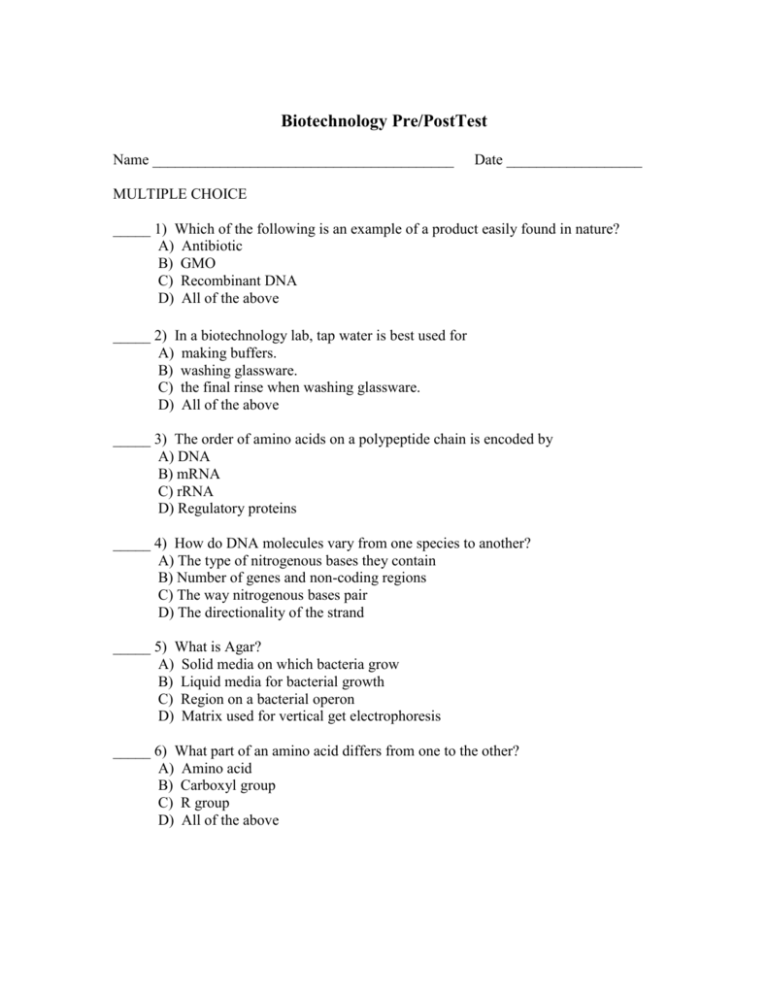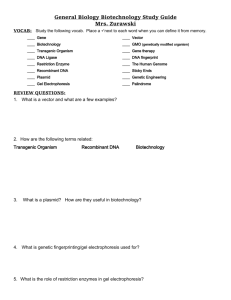Biotechnology Pre-Test
advertisement

Biotechnology Pre/PostTest Name ________________________________________ Date __________________ MULTIPLE CHOICE _____ 1) Which of the following is an example of a product easily found in nature? A) Antibiotic B) GMO C) Recombinant DNA D) All of the above _____ 2) In a biotechnology lab, tap water is best used for A) making buffers. B) washing glassware. C) the final rinse when washing glassware. D) All of the above _____ 3) The order of amino acids on a polypeptide chain is encoded by A) DNA B) mRNA C) rRNA D) Regulatory proteins _____ 4) How do DNA molecules vary from one species to another? A) The type of nitrogenous bases they contain B) Number of genes and non-coding regions C) The way nitrogenous bases pair D) The directionality of the strand _____ 5) What is Agar? A) Solid media on which bacteria grow B) Liquid media for bacterial growth C) Region on a bacterial operon D) Matrix used for vertical get electrophoresis _____ 6) What part of an amino acid differs from one to the other? A) Amino acid B) Carboxyl group C) R group D) All of the above _____ 7) How can colorless proteins be monitored during electrophoresis? A) Coomassie blue stain B) Silver stain C) PAGE loading dye D) Ethidium bromide _____ 8) Which of the following is a codon? A) ATA B) UAU C) Tyrosine D) All of the above _____ 9) What is the purpose for SDS during electrophoresis? A) Stain the proteins for visualization B) Use as a loading dye C) Denature the proteins and give them a negative charge D) Conduct electricity _____ 10) Which of the following is an example of a product easily found in nature? A) Antibiotic B) GMO C) Recombinant DNA D) All of the above _____ 11) What are the most common molecules in cells? A) Sugars B) Lipids C) Proteins D) Nucleic acids _____ 12) Glucose is a A) peptide. B) polysaccharide. C) disaccharide. D) monosaccharide _____ 13) A) B) C) D) Where does translation occur in prokaryotes? In the endoplasmic reticulum At the ribosomes Outside the cell In the nucleus Please match the word with the description. Activity assays Concentration assays Molarity Buffer pH Biotechnology Translation ELISA Genetic engineering PK/PD assays Transcription Plasmids Spectrophotometry HPLC Acid Assay Recombinant DNA Bacteria cells Potency assays Gene therapy Genetic disorders Gel electrophoresis Chromatography 14) A process of making an RNA code from DNA _____________________________________ 15) A process in which RNA is decoded and polypeptides are formed _____________________________________ 16) Extra small rings present in some bacteria _____________________________________ 17) Modifications of DNA code of an organism _____________________________________ 18) Parkinson's, diabetes, cystic and fibrosis (CF) are examples of _____________________________________ 19) Do not contain nucleus or membrane bound organelle So, DNA is floating in cytoplasm _____________________________________ 20) Helps researchers measure the amount of protein present _____________________________________ 21) Determines the amount and length of activity for a given protein in a test organism _____________________________________ 22) Shows if a specific protein is present and conducting the expected reaction _____________________________________ 23) A highly specific test to determine protein concentration based on a particular a antigen-antibody interaction _____________________________________ 24) Used for understanding the relationship between dosage and activity of a given pharmaceutical _____________________________________ 25) A test for determining the presence or a particular characteristic of a protein of interest _____________________________________ 26) An aqueous solution that ionizes and yields hydrogen ion _____________________________________ 27) A solution that resists changes in pH _____________________________________ 28) A measurement of the concentration of hydrogen ion in a sample _____________________________________ 29) Separation of molecules on or through a stationary phase _____________________________________ 30) Quantitative study of electromagnetic spectra deals with visible light, nearultraviolet, and near-infrared light sources _____________________________________ 31) Form of liquid chromatography used to separate compounds that are dissolved in solution. Instruments consist of a reservoir of mobile phase, a pump, an injector, a separation column, and a detector _____________________________________ 32) Defined as the moles of solute per liter of solution _____________________________________ 33) Using electricity to separate molecules on a gel slab _____________________________________ 34) Process of correcting DNA codes that cause genetic diseases and disorders _____________________________________ 35) The study and manipulation of living things or their components _____________________________________ 36) A combination of DNA from different sources in one molecule _____________________________________ Answer the following questions. 37) A piece of one strand of a DNA molecule has the following code on it ATG CCC GTG TTA AAA TGT GGG ATC CCC GGT GTG CCC TTA What is the nitrogen base code on the opposite DNA strand? 38) A piece of structural gene has the code TAC CCC ATG GGG TAA GGC GTC What is the mRNA transcript made? This project is funded by a grant awarded under the President’s Community Based Job Training Grant as implemented by the U.S. Department of Labor’s Employment and Training Administration (CB-15-162-06-60). NCC is an equal opportunity employer and does not discriminate on the following basis: against any individual in the United States, on the basis of race, color, religion, sex, national origin, age disability, political affiliation or belief; and against any beneficiary of programs financially assisted under Title I of the Workforce Investment Act of 1998 (WIA), on the basis of the beneficiary’s citizenship/status as a lawfully admitted immigrant authorized to work in the United States, or his or her participation in any WIA Title I-financially assisted program or activity. This product was funded by a grant awarded under the President’s High Growth Job Training Initiative, as implemented by the U.S. Department of Labor’s Employment & Training Administration. The information contained in this product was created by a grantee organization and does not necessarily reflect the official position of the U.S. Department of Labor. All references to nongovernmental companies or organizations, their services, products, or resources are offered for informational purposes and should not be construed as an endorsement by the Department of Labor. This product is copyrighted by the institution that created it and is intended for individual organizational, non-commercial use only.








